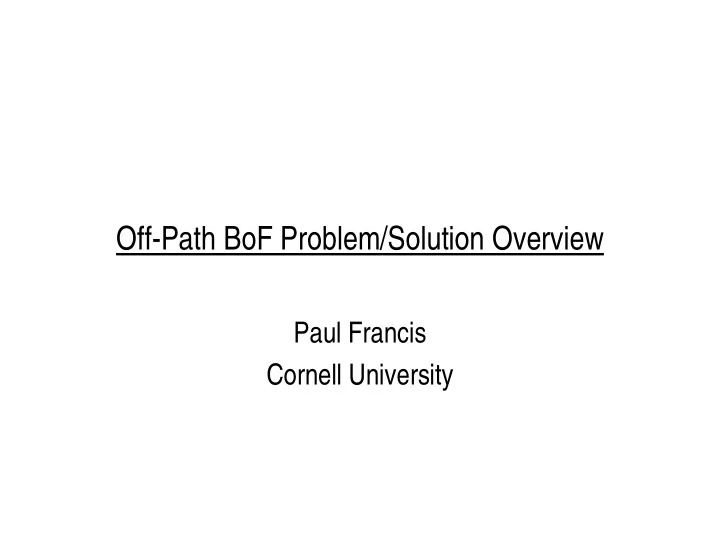

Off-Path BoF Problem/Solution Overview Paul Francis Cornell University
Research Goal • Robust, secure, connection establishment – Robust: always works • Even if behind NATs, firewalls, different network layers – Secure: In a firewall sense---allow connections you want, disallow those you don’t want • In other words: do what IP addresses , ports , and DNS names were meant to do in the original IP architecture
More technology goals • Only meant for “non-public client-server” connections – cnn.com can still use addr/port • Name-based – User-friendly – Not tied to a single network layer – Or to a network access point • Provide firewalls (construed broadly) with information they need to make go/no-go decisions – Authenticated, named endpoints and applications
More technology goals • Be explicit about all the policy players – Allow for control at ends and middles – Let market/courts decide who controls what • Negotiation of connection parameters – Type of security (IPsec, SSH, SSL, …) – Type of transport (TCP, UDP, SCTP, HIP, …) – Type of network (v4, v6, other?) – Routing through middleboxes?
Non-goals • QoS
Ultimately: New “sockets” layer • The set of functions an application can count on – In the OS and Infrastructure • Today: IP, DNS • Goal: Ubiquitous and generic support for signaling – Lets just call this “newsock” for now
BoF goals: IRTF • Discuss creation of an IRTF group • Drum up interest in an IRTF group – (assuming folks think it is a good idea) • Why not just call up my research buddies? – Want mix of research and practice – Want a focused output---protocols and prototypes • Why is this a TSV BoF (and not “IRTF BoF”)??? – Some procedural thingy…
Why a signaling approach? Some observations: • STUN + ICE + Behave – Looks like an increasingly effective way to get UDP through NAT boxes – And firewalls: an issue we’ll have even with pure IPv6! • Folks have figured out how to do this for TCP as well • These signaling-based approaches have some nice properties • Why not generalize this approach for data, expand to explicitly include firewall participation, and standardize its operation?
A quick technical overview • Hosts data path is “default off” – Like private hosts today • Hosts have an “default on” signaling path – Path decoupled – Goes through “policy boxes”, which may be far away from host (and which are also co-resident with hosts) • Allow DoS-resistant screening of “invites” – Access control occurs in policy boxes • Based on authenticated and named endpoints and applications
A quick technical overview If an invite is approved by all involved parties: • If legacy firewall: – Connection behaves as if internally initiated (at both ends) • If newsock firewall: – Policy boxes create secure tokens that are used to traverse on-path firewalls
How are connections established today? • Various ad hoc ways… • Manual configuration of NAT/firewall box – SSH port, per-application ports • DynDNS – Lacks privacy… • Various IM-signaled applications – I.e., setup file transfer via IM “signaling” • These push access control to the individual applications, leave the firewalls (personal or otherwise) in the cold • Popularity of dyndns and IM apps suggests that there is a need for name-based, signaled connection establishment?
Need for newsock? • Popularity of dyndns and IM apps suggests that there is a need for name-based, signaled connection establishment in the sockets layer… • Would be nice if all this were standard and ubiquitously supported by OS and ISP…
Related standards efforts (AFAIK) • IPv6 – Has firewall traversal issue – Will co-exist with IPv4 for the foreseeable future: NAT traversal an ongoing issue – Uses DNS for naming, but privacy issue here – Philosophically: IPv4 originally meant as a way to allow different networks to inter-operate…newsock would hearken back to that
Related standards efforts (AFAIK) • nsis – NAT/FW calls for some off-path signaling method (i.e. to find IP address of remote host) – NAT/FW still very addr/port centric – nsis could serve as the on-path component – Newsock and nsis are complementary • HIP – Newsock and HIP are also complementary – Newsock could be used to negotiate the use of HIP, and to discover the HIP ID – HIP ID could serve as the secure token provided by newsock policy boxes
Related standards efforts (AFAIK) • TiSPAN – Not sure about this…looks very provider-centric and massive (includes QoS, for instance) • Midcom – Is this defunct? • SIMPLE – Related in many ways – But focused on a specific application (presence and messaging) • Dynamic DNS – Not really signaling
Proposed IRTF group activity • Mix of research and practice • Focused: goal to produce protocol and prototype • Develop requirements: find the simplicity/functionality sweet-spot • Design on-path and off-path protocols – Blank-slate approach…only later see if existing protocols can be exploited
Many open problems • Policy box discovery • Design of on-path signaling protocol • Attacks on policy boxes – Out-of-band? (nsis), in-band? – DoS, others (HIP) • Design of off-path signaling • Coupling of off-path and on- protocol (lessons learned from path phases (security issues?) SIP?) • Dealing with legacy firewalls – Naming • Dealing with legacy – Negotiation applications – Mobility? – Sockets interception library • Dealing with endpoints that lie – Derive trust from endpoint domain? – Trusted Platform Module hardware?
Recommend
More recommend